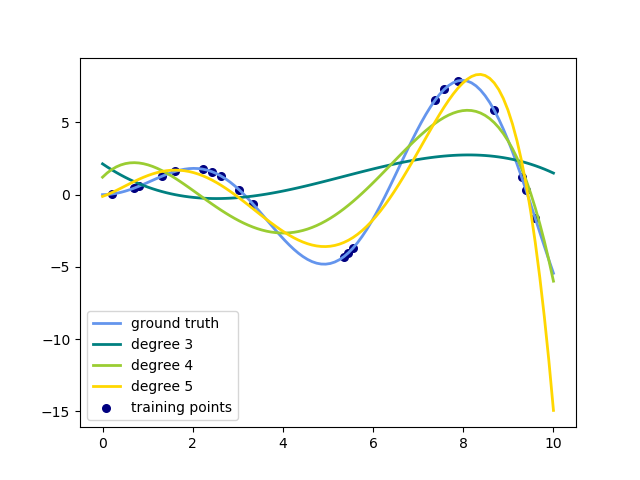多项式插值¶
这个例子演示了如何用岭回归用n_degree多项式逼近一个函数。具体而言,从n_samples 1D点 出发,建立Vandermonde矩阵就足够了,它是n个样本 x n_degree+1,其形式如下:
[[1, x_1, x_1 ** 2, x_1 ** 3, …],
[1, x_2, x_2 ** 2, x_2 ** 3, …], …]
直观地说,这个矩阵可以解释为伪特征矩阵(提高到某种幂的点)。该矩阵类似于(但不同于)由多项式核导出的矩阵。
此示例显示,您可以使用线性模型进行非线性回归,使用pipeline添加非线性特性。核方法扩展了这一思想,可以诱导出非常高(甚至无限)维数的特征空间。

print(__doc__)
# Author: Mathieu Blondel
# Jake Vanderplas
# License: BSD 3 clause
import numpy as np
import matplotlib.pyplot as plt
from sklearn.linear_model import Ridge
from sklearn.preprocessing import PolynomialFeatures
from sklearn.pipeline import make_pipeline
def f(x):
""" function to approximate by polynomial interpolation"""
return x * np.sin(x)
# generate points used to plot
x_plot = np.linspace(0, 10, 100)
# generate points and keep a subset of them
x = np.linspace(0, 10, 100)
rng = np.random.RandomState(0)
rng.shuffle(x)
x = np.sort(x[:20])
y = f(x)
# create matrix versions of these arrays
X = x[:, np.newaxis]
X_plot = x_plot[:, np.newaxis]
colors = ['teal', 'yellowgreen', 'gold']
lw = 2
plt.plot(x_plot, f(x_plot), color='cornflowerblue', linewidth=lw,
label="ground truth")
plt.scatter(x, y, color='navy', s=30, marker='o', label="training points")
for count, degree in enumerate([3, 4, 5]):
model = make_pipeline(PolynomialFeatures(degree), Ridge())
model.fit(X, y)
y_plot = model.predict(X_plot)
plt.plot(x_plot, y_plot, color=colors[count], linewidth=lw,
label="degree %d" % degree)
plt.legend(loc='lower left')
plt.show()
脚本的总运行时间:(0分0.091秒)
Download Python source code:plot_polynomial_interpolation.py
Download Jupyter notebook:plot_polynomial_interpolation.ipynb




